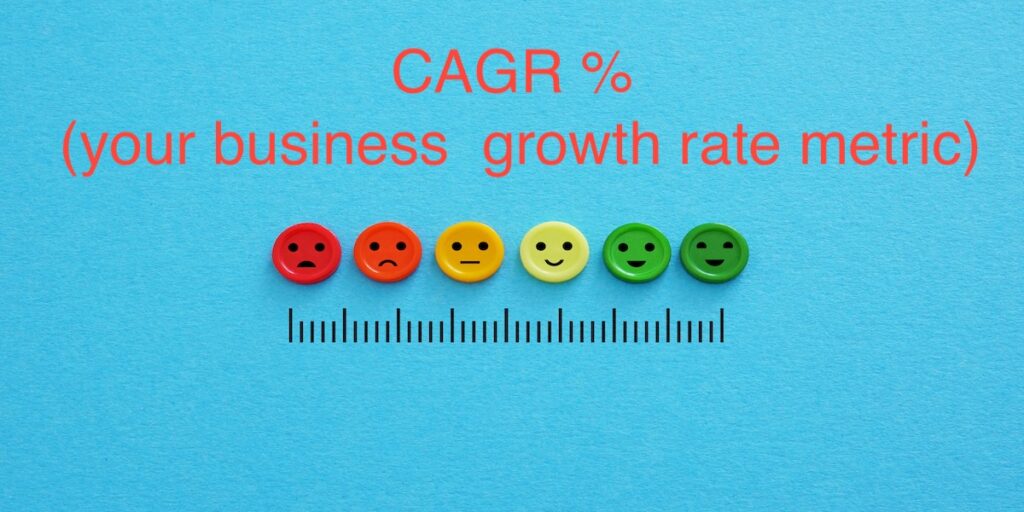Article Contents:
The power of one metric to look at your business growth differently
Most small business owners know how much they earned last year. Many even track how much their revenue grew compared to the previous year.
But very few business owners step back and ask:
“Over the last five or ten years, how has my business really grown?”
“Is my growth consistent or just a few good years hiding behind average ones?”
The answer lies in a metric that most small business owners overlook: CAGR (Compound Annual Growth Rate).
It is simple to calculate, powerful to interpret, and eye-opening.
Let us explore what CAGR means, why it matters, and why small business owners like you must start measuring it.
What is CAGR and why should you care?
CAGR shows you the average annual growth rate of your business over a period of time, assuming steady, compounding growth.
It smooths out the ups and downs and tells you:
“If I had grown at a steady rate every year, what would that rate be to reach where I am now?”
For example:
If your revenue grew from ₹ one crore to ₹ two crore in 5 years, your CAGR is:
CAGR formula=(Ending value / Beginning value) ^(1/n) – 1
Where:
Ending Value = Final year revenue
Beginning Value = Starting year revenue
n = Number of years you are considering, say 3 years or 5 years or 10 years and so on
( 2/1)^(1/5) =14.9 %
that means, your business is grown on average of 15 % every year.
Even if your actual growth varied each year, the CAGR tells your real trajectory. it shows the trend.
Why small business owners are not measuring CAGR
In my consulting experience with over 150 SMEs, I rarely see founders calculate this.
The reason could be
They are focused on day-to-day or year-on-year numbers.
It is natural. You look at this year’s sales, compare them to last year’s, and call it growth.They are unaware of this metric
It is often seen as a financial or investor term, not something relevant for SME business owners’ decision-making.They lack long-term data.
Many businesses do not maintain or analyze multi-year records. They track revenue, but not the story behind it.
But here is the truth:
CAGR is not a financial concept. It is a leadership lens.
It helps you understand whether your efforts are compounding or just scattered wins.
YoY growth % vs CAGR%: What is the difference?
| Metric | What it shows | Limitation |
|---|---|---|
| Year-on-Year | Growth compared to last year | Can be misleading if the last year was unusually high or low |
| CAGR | Average annual compounded growth over time | Requires multi-year data, but gives truer picture |
YoY is like checking your speed this year alone.
CAGR is like looking at your average pace across the entire journey.
My consultancy business example
When I started my independent consulting practice, I had only one client and one assignment. Over time, through consistent value delivery, relationship building, and reinvestment, the practice expanded.
Today, when I look back over the last 13 years, my business has grown at 18% CAGR.
That number might not look flashy at first glance. But think about it—18% average annual growth over 13 years is substantial. It means the business has multiplied in size several times, steadily and sustainably.
It did not come from a few lucky years. It came from doing the right things again and again.
This metric reminds me that consistency matters more than intensity or quick,short term wins.
What is a “good” CAGR for small businesses?
There is no universal benchmark. But here is a useful guide:
0–5% CAGR: Low growth or stagnant. The business head may require rethinking the strategy.
6–10%: Stable, but room to improve.
11–20%: Strong and healthy. Indicates solid fundamentals.
Above 20%: High growth. Great if profitability and systems are strong.
Even a 12–15% CAGR over 8–10 years is a sign of an excellent business, especially if it comes with healthy cash flows and margins.
Why should you start tracking CAGR today for your business?
This metric helps you:
Pause and reflect on the real direction of your business both on sales growth and profitability growth.
Avoid the illusion of growth caused by one or two good years
Set meaningful long-term goals
Explain your business strength to bankers, investors, or even future leaders
Develop a compounding mindset, not a chasing mindset
This is not about being technical.
It is about leading your business with clarity.
Summary and Reflection as a business owner
When was the last time you looked at your 5-year or 10-year growth with fresh eyes?
Do you know your business’s sales growth rate and profit growth rate?
What would that number reveal about your leadership and your business model?
If the number surprises you, what will you do differently from here?
Call to Action:
Pull out your revenue or profit numbers for the past 5–10 years.
Use a simple CAGR calculator or reach out, and I will help you interpret it.
Once you know your rate of growth, you will never look at your business performance the same way again.
Because true growth is not about last year’s win.
It is about the journey and what it tells you.



